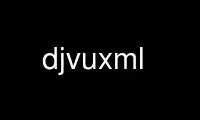
This is the command djvuxml that can be run in the OnWorks free hosting provider using one of our multiple free online workstations such as Ubuntu Online, Fedora Online, Windows online emulator or MAC OS online emulator
PROGRAM:
NAME
djvutoxml, djvuxmlparser - DjVuLibre XML Tools.
SYNOPSIS
djvutoxml [options] inputdjvufile [outputxmlfile]
djvuxmlparser [ -o djvufile ] inputxmlfile
DESCRIPTION
The DjVuLibre XML Tools provide for editing the metadata, hyperlinks and hidden text
associated with DjVu files. Unlike djvused(1) the DjVuLibre XML Tools rely on the XML
technology and can take advantage of XML editors and verifiers.
DJVUTOXML
Program djvutoxml creates a XML file outputxmlfile containing a reference to the original
DjVu document inputdjvufile as well as tags describing the metadata, hyperlinks, and
hidden text associated with the DjVu file.
The following options are supported:
--page pagenum
Select a page in a multi-page document. Without this option, djvutoxml outputs the
XML corresponding to all pages of the document.
--with-text
Specifies the HIDDENTEXT element for each page should be included in the output.
If specified without the --with-anno flag then the --without-anno is implied. If
none of the --with-text, --without-text, --with-anno, or --without-anno, flags are
specified, then the --with-text and --with-anno flags are implied.
--without-text
Specifies not to output the HIDDENTEXT element for each page. If specified without
the --without-anno flag then the --with-anno flag is implied.
--with-anno
Specifies the area MAP element for each page should be included in the output. If
specified without the --with-text flag then the --without-text flag is implied.
--without-anno
Specifies the area MAP element for each page should not be included in the output.
If specified without the --without-text flag then the --with-text flag is implied.
DJVUXMLPARSER
Files produced by djvutoxml can then be modified using either a text editor or a XML
editor. Program djvuxmlparser parses the XML file inputxmlfile in order to modify the
metadata of the corresponding DjVu file.
-o djvufile
In principle the target DjVu file is the file referenced by the OBJECT element of
the XML file. This option provides the means to override the filename specified in
the OBJECT element.
DJVUXML DOCUMENT TYPE DEFINITION
The document type definition file (DTD)
/usr/share/djvu/pubtext/DjVuXML-s.dtd
defines the input and output of the DjVu XML tools.
The DjVuXML-s DTD is a simplification of the HTML DTD:
http://www.w3c.org/TR/1998/REC-html40-19980424/sgml/dtd.html
with a few new attributes added specific to DjVu. Each of the specified pages of a DjVu
document are represented as OBJECT elements within the BODY element of the XML file. Each
OBJECT element may contain multiple PARAM elements to specify attributes like page name,
resolution, and gamma factor. Each OBJECT element may also contain one HIDDENTTEXT
element to specify the hidden text (usually generated with an OCR engine) within the DjVu
page. In addition each OBJECT element may reference a single area MAP element which
contains multiple AREA elements to represent all the hyperlink and highlight areas within
the DjVu document.
PARAM Elements
Legal PARAM elements of a DjVu OBJECT include but are not limited to PAGE for specifying
the page-name, GAMMA for specifying the gamma correction factor (normally 2.2), and DPI
for specifying the page resolution.
HIDDENTEXT Elements
The HIDDENTEXT elements consists of nested elements of PAGECOLUMNS, REGION, PARAGRAPH,
LINE, and WORD. The most deeply nested element specified, should specify the bounding
coordinates of the element in top-down orientation. The body of the most deeply nested
element should contain the text. Most DjVu documents use either LINE or WORD as the
lowest level element, but any element is legal as the lowest level element. A white space
is always added between WORD elements and a line feed is always added between LINE
elements. Since languages such as Japanese do not use spaces between words, it is quite
common for Asian OCR engines to use WORD as characters instead.
MAP Elements
The body of the MAP elements consist of AREA elements. In addition to the attributes
listed in
http://www.w3.org/TR/1998/REC-html40-19980424/struct/objects.html#edef-AREA,
the attributes bordertype, bordercolor, border, and highlight have been added to specify
border type, border color, border width, and highlight colors respectively. Legal values
for each of these attributes are listed in the DjVuXML-s DTD. In addition, the shape oval
has been added to the legal list of shapes. An oval uses a rectangular bounding box.
Use djvuxml online using onworks.net services
